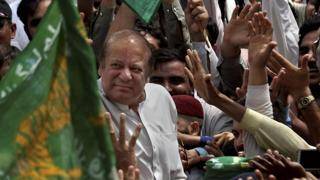How Nawaz Sharif political stunt can backfire this time
Shares

s political history is full of power shows, street rallies and long marches, some successful, some destructive. On Wednesday, ousted and disqualified prime minister Nawaz Sharif started what he cynically called a drive back home. Many saw this march as his last-ditch attempt to undo a devastating Supreme Court decision against him and to pre-empt corruption cases that could land him and his family in jail.
Amid jets and helicopters flying over Islamabad and despite warnings by security agencies including the Military Intelligence, Inter-Services Intelligence and Intelligence Bureau that there were terrorist threats on the 170-mile long Grand Trunk Road to Lahore, Sharif took to the streets in desperation.
The ousted leader has used such street demonstrations of power several times in the past, as have others including late Benazir Bhutto and Imran Khan.
Sharif’s last such outing was in 2009 when he started a march to seek restoration of Supreme Court chief justice Iftikhar Choudhry who was sacked by General Pervez Musharraf in 2007.
Despite promises, the new President Asif Ali Zardari refused to reinstate him and thus Sharif led a lawyers and civil society march in 2009 for his restoration.
Immediately the then army chief, General Ashfaq Kayani, intervened and the chief justice was restored before Sharif could leave his stop over at Gujranwala in central Punjab. It was a big success for Sharif, the then Opposition leader and a blow to Zardari.But it was the army, which put its stamp on national politics, regaining ground lost during General Musharraf’s nine years. Ironically when Sharif took to the streets then he was fighting for the judiciary.
His march now is against the judges, who have rendered a verdict in the Panama Papers case, ending his political career, removing him from both the prime minister’s office and the all-important head of his party. It is now a battle for his survival.
Traditionally long marches in Pakistan have produced destructive results against democracy.
In 1958, Khan Abdul Qayyum Khan of Frontier province, the home of Frontier Gandhi, Ghaffar Khan, led a march from Peshawar to Rawalpindi and military rule was instantly imposed by General Ayub Khan.When Zulfikar Ali Bhutto came to power and rigged elections in 1977, similar street shows by the opposition led to General Zia ul Haq’s 11-year long martial law. In the decade of 90s, Benazir Bhutto and Nawaz Sharif alternatively took to the streets and toppled each other, mostly with the help of the deep establishment. In 2000, General Musharraf sent Sharif into exile for seven years.
On his return in 2007 and after Benazir Bhutto’s murder, Sharif started off where he had left and in 2009 he led the march for the judiciary. He was paid back in 2014 when now opposition leader Imran Khan marched on Islamabad from Khyber Pakhtunkhwa against rigged elections. Sharif barely escaped then.
Imran Khan again marched on Islamabad in 2016 against corruption of Sharif, revealed by Panama Papers and this time succeeded in forcing the Supreme Court to take up the case which finally ended in Sharif’s ouster from power in July.
The important factor is that while street power has played a significant role in changing political fortunes, it was always the deep establishment — army and judiciary — that took life and death decisions.
Contrary to the past, Nawaz Sharif’s protest now is to save his own skin and his family, facing charges of widespread corruption.
Interestingly the two key players of the deep establishment are either neutral or opposed to him and his show on the streets could misfire big time as there is no larger democratic principle involved. Sharif keeps talking of a deep conspiracy but has not revealed anything as he wants to charge sheet the army and the judiciary. His dilemma is that publicly he cannot accuse anyone.
He has lost his office and his party. He fears the family will also slip out of his hands.
